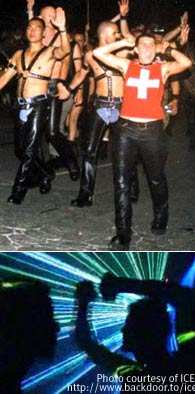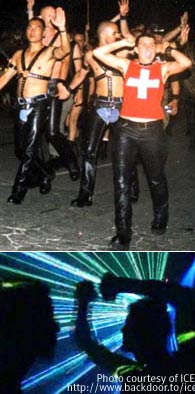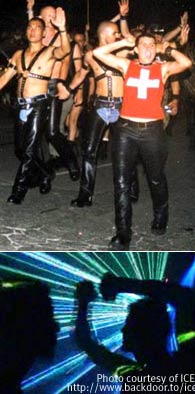The ideology of early homosexual liberation aimed to be an all-inclusive movement. But today's strength of the Mardi Gras parade reveals a victory for conservatism over radicalism.

The introduction in 1979 of the Public Assemblies Act of New South Wales placed the onus on the police to prove that a march would cause a public nuisance or a danger before a permit could be refused. Less than one year after demonstrators clashed with the police, organizers of the Sydney Mardi Gras street parade actively sought out permission to exist as a legal entity.
As late as 1992, the organization continued to recognize that this relationship with the police was one "based on co-operation, even if it was just at the level of effective crowd control." But early organizers had been willing to accept the fa�ade of acceptance because they wanted to encourage participation in a "legitimate" celebration. They wanted people to feel safe enough to come out en masse and thereby expose the size of the gay community. While these aims were reported to have been decreed "by consensus", an amendment to include additional recognition of the parade as a demonstration in favor of gay rights was simultaneously voted down.
As a newly formed Gay Mardi Gras Task Force began to wrangle over what should be deemed permissible content in the parade, conservatism pushed radicalism aside. It was concluded that although the limits would be set by the participants, "in the interest of gay unity, people taking part should not offend other gays." This statement assumed there ever could or should be any consensus of agreement among gay people. It suggested boundaries of acceptable gay conduct but failed to clarify what these were.

A further decision to shift the timing of all future parades from 1981 to summer was justified on the grounds that it left the Stonewall Day in June for a more militant demonstration. Such a blatant acknowledgment of depoliticisation distanced the gay Mardi Gras from the core of its own history. What had started out as a spontaneous demonstration to mark the anniversary of a homosexual stand against police brutality and mafia-controlled bars in New York was systematically transformed into a self-regulated party of celebration and dancing that relied on police protection and encouraged the support of profit-driven businesses.
This change from spontaneity and revolution towards restrictions and regulations signaled what one critical voice in the gay press referred to as a "split between the right and left wings of Sydney's gay scene." The left wanted the politics. The right wanted the disco. Speaking on Gaywaves, a radio program aired on 2SER, Annie Parkinson summed up the radicals' mood when she accused the gay male of turning his back on history and heading towards a non-political hedonism which offered no contribution to the dismantling of "destructive patterns of current sexual mores".
As the Mardi Gras grew in size, it began to take on the most visible face of Australian gayness. It now claims a national audience of millions. Its desire to portray the homosexual world as exclusive from the heterosexual world is symbolized by the erecting of crowd-controlling barriers along the parade route. Each year, homosexuality is locked in a new closet.
By announcing itself as a "celebration of coming out", the Mardi Gras claims ownership over all oppressed people who question their heterosexuality; and seeks to bring them into the dancing cage where it believes they all belong. "We make the assumption that anyone who is gay, lesbian or transgender agrees with the aims and objections of Mardi Gras as an organization," stated Rob Patmore, the one-time "President" of the force.

At the end of the Mardi Gras parade stands a party which fails to take place in the open as a true display of sexual tolerance, but has become encased in the creation of an exclusive gay identity. "It's obvious that some straights just won't listen!" declared a 1991 Mardi Gras Newsletter. Those who slip into the "old way of thinking" and refuse to observe new rules of gay "etiquette" now risk the punishment of exclusion that gays declare to be unjust when dished out to them. In a 1979 edition of Gay Community News, Ian Jordan pointed out that under a system which relies on self-identification, "a gay nazi is more welcome (in theory) than a heterosexual who supports gay rights."
A system that seeks to segregate the homosexual from the heterosexual, and bind these sexualities by permanence, denies the rights of those who wish to explore the early liberationists' ideals of a multi-faceted sexuality. Bisexuality, in particular, seems to threaten the current structure of the Mardi Gras because it suggests the possibility of a merging of the homosexual and the heterosexual worlds. The Mardi Gras' insistence on maintaining its own definition of gayness discourages full sexual liberation. It merely allows the oppressed homosexual to be the oppressors of heterosexuals for one short moment in time. The general permissive tolerance of the dominant society towards the whole Mardi Gras event proves that it does not feel overly threatened by this level of confrontation.
"Liberation as a project encompassing the revolutionary overthrow of all existing structures had a fairly dreamlike feel to it," writes Willett in his recent book, Living Out Loud. "But its great goal - the creation of a world in which oppression and persecution are a mere memory and in which real freedom of choice and new kinds of relationships and new sexualities prevail - seems worth remembering."
Dean Durber works as a freelance writer. He is currently based in Perth, where he is conducting doctorate research into contemporary constructions of Australian homosexuality at Curtin University. Dean Durber can be contacted at deandurber@one.net.au.











 列印版本
列印版本











讀者回應
搶先發表第一個回應吧!
請先登入再使用此功能。